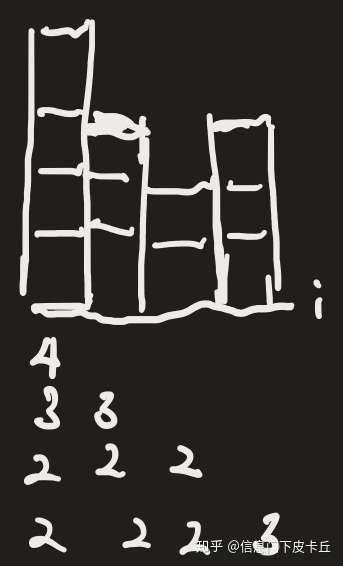1504. Count Submatrices With All Ones
https://leetcode.com/problems/count-submatrices-with-all-ones/
Given a rows * columns matrix mat of ones and zeros, return how many submatrices have all ones.
Example 1:
Input: mat = [[1,0,1],
[1,1,0],
[1,1,0]]
Output: 13
Explanation:
There are 6 rectangles of side 1x1.
There are 2 rectangles of side 1x2.
There are 3 rectangles of side 2x1.
There is 1 rectangle of side 2x2.
There is 1 rectangle of side 3x1.
Total number of rectangles = 6 + 2 + 3 + 1 + 1 = 13.Example 2:
Input: mat = [[0,1,1,0],
[0,1,1,1],
[1,1,1,0]]
Output: 24
Explanation:
There are 8 rectangles of side 1x1.
There are 5 rectangles of side 1x2.
There are 2 rectangles of side 1x3.
There are 4 rectangles of side 2x1.
There are 2 rectangles of side 2x2.
There are 2 rectangles of side 3x1.
There is 1 rectangle of side 3x2.
Total number of rectangles = 8 + 5 + 2 + 4 + 2 + 2 + 1 = 24.Example 3:
Example 4:
由01组成的矩阵,问其中有多少个由1组成的长方形。矩阵 + count => DP。遍历到(i, j), 如下图

观察到新引入的长方形分别是在第i行到(i, j)连着的1,长度4对应个数4;i和i-1行能拼成的长方形长度3,额外长方形个数3;依此类推,长度一但缩短,之后遍历能拼成的长方形长度最长只能到缩短后的长度,最后对应4 + 3 + 2 + 2。也就是从i行往上遍历,k in [i, 0],第k行从左到j最长连续1的个数的dp[k][j],mi位当前遍历到的最短长度,mi=min(mi, dp[k][j]),res += mi。
进一步,将一整行看作是有不同高度的histogram,这一行对应新增加的长方形为histogram能形成的长方形数目,从左往右以每一列为底的新长方形数目如图:

和上个解法同理,从右往左遍历k in [j, 0],mi为当前遍历的最短高度,res += mi(k) for all k。此时如果能统计出以heights[j]向左最远能到的位置如peek,再加上peek前的结果也就是对j列所求。比如图中最后一列(2+2+2 + 3)前面三个2为之前第3列所求,最后的3为当前列的高度*它对应的宽度1。让dp[k]记录第k列所增加的新长方形数目。求最远能扩所少想起Largest Rectangle in Histogram,类似的按高度递增的stack内记录index,不同在于这次宽度不是对每个弹出的元素做计算,而是所有弹出后计算i和peek的diff:

思路和代码参考自这。
Last updated
Was this helpful?